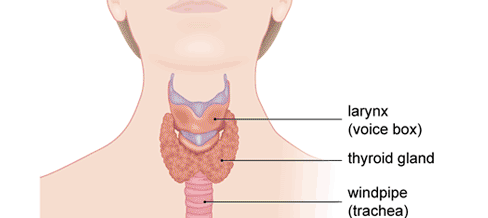Thyroid cancer is a rare form of cancer that starts in your thyroid gland. Your thyroid gland lies at the base of your neck and produces hormones to help control how your cells and organs work.
Around 3,400 people are diagnosed with thyroid cancer each year in the UK. The chance of getting thyroid cancer increases as you get older. It’s more common in women, and women are more likely to get thyroid cancer in their 30s and 40s than men.
There are several different types of thyroid cancer. In most cases thyroid cancer can be treated. The type of treatment your doctor offers you will depend on the type of thyroid cancer you have and whether it has spread.

The thyroid gland
Your thyroid gland lies at the front of your neck, just below your Adam’s apple. It’s made up of two lobes, each the size of half a plum, connected by a bridge of thyroid tissue.
Your thyroid is an endocrine gland, which means it makes hormones and releases them directly into your bloodstream. The main hormones produced by your thyroid gland are called T3 (triiodothyronine) and T4 (thyroxine). They help to control the speed at which your body uses energy – your metabolic rate. You may have come across conditions where the thyroid gland is overactive (hyperthyroidism) or underactive (hypothyroidism). These are common problems linked to the levels of T3 and T4 in your body.
Your thyroid gland also makes another hormone, called calcitonin. This helps to control the amount of calcium in your bloodstream.
Types of thyroid cancer
There are four main types of thyroid cancer. These are listed below.
- Papillary thyroid cancer is the most common type and makes up about eight in 10 of all thyroid cancers. It’s usually slow growing but can sometimes spread to nearby lymph nodes. It’s most common in women and younger people.
- Follicular thyroid cancer is less common than papillary thyroid cancer and usually affects slightly older people. It accounts for about one in 10 of all cases of thyroid cancer. It sometimes spreads to other parts of your body, such as your lungs or bones.
- Medullary thyroid cancer is rare and affects around four out of every 100 people with thyroid cancer. It typically affects people in their 40s and 50s. It’s sometimes passed down in families.
- Anaplastic thyroid cancer is also rare. It tends to grow more quickly than the other types and can be more difficult to treat. Around three in 100 people with thyroid cancer have this type. It’s more common in older people and women.
Because of the way they develop and are treated, the papillary and follicular types are sometimes grouped together and called ‘differentiated’ thyroid cancers.
It’s also possible to get another type of cancer, called lymphoma in your thyroid gland.
Symptoms of thyroid cancer
The main symptom of thyroid cancer is finding a painless lump in the front of your neck. It’s important to remember that lumps in the thyroid gland are quite common, and most are benign (not cancer). Only about one in 20 thyroid lumps are cancer.
Other, less common symptoms of thyroid cancer may include:
- a cough that doesn’t go away
- difficulty swallowing
- breathing problems
- a hoarse voice
However, these symptoms can also be caused by problems other than thyroid cancer. If you have any of these symptoms, contact your GP.
Diagnosis of thyroid cancer
Your GP will ask about your symptoms and examine you, including your head and neck. They might recommend a blood test to check the hormones produced by your thyroid gland.
If your GP thinks you may have a thyroid tumour, they’ll refer you to a doctor who specialises in thyroid cancer. Your specialist doctor may recommend further tests, including the following.
- A blood sample to recheck the thyroid hormone levels in your blood and see how well your thyroid gland is working.
- An ultrasound scan of your neck. This uses sound waves to produce an image of your thyroid. Your doctor may take a needle biopsy of the lump at the same time (see next point).
- Needle biopsy (fine needle aspiration cytology, FNAC). Your doctor uses a small needle to remove some cells from the lump in your neck. These go to a laboratory for testing to find out if the cells are cancerous.
If these tests show you have thyroid cancer your doctor may recommend further tests to see if it has spread. These may include the following.
- CT scan. This uses X-rays to see the organs inside your body.
- MRI scan. This uses magnets and radiowaves to produce images of the inside of your body.
If your doctor recommends these or other tests they’ll carefully explain what each involves. Feel free to ask any questions you have.
Treatment of thyroid cancer
The treatment of thyroid cancer depends on what type it is, whether it’s spread to other areas and your general health. You’ll have a team of doctors and other cancer specialists involved in planning your care. Your doctor will explain your options and take your wishes into account.
Surgery
Surgery is the most common treatment for thyroid cancer. Your surgeon may recommend an operation to remove part of your thyroid gland (partial thyroidectomy) or all of it (total thyroidectomy). Lymph nodes near your thyroid gland may also be removed to see if they contain cancerous cells. The type of surgery you have will depend on several things including the size of the tumour (lump) and how far the cancer has spread.
You’ll have this surgery under a general anaesthetic, which means you’ll be asleep during the procedure.
